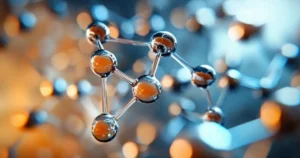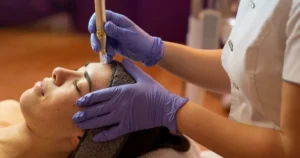Table of Contents
Are you looking to rejuvenate your skin for a brighter, more youthful appearance? A chemical peel may be the answer. This popular cosmetic treatment targets skin concerns, from fine lines and wrinkles to hyperpigmentation, and enhances overall skin texture. Understanding how a chemical face peel works, its benefits, and what to expect from a chemical peel before and after can help you make an informed decision. In this blog, we’ll discuss the process of a chemical peel and the science behind its effectiveness, answering common questions patients might have. So, let’s dive into the details and explore the science behind this transformative treatment.
What is a Chemical Peel?
A chemical peel is a controlled skin-resurfacing treatment that involves applying a specially formulated acidic solution to the skin. This solution triggers a process that exfoliates the outermost layers of skin, allowing new, fresh skin cells to come to the surface. A chemical peel can address hyperpigmentation, sun damage, acne scars, and fine lines.
Chemical peels are typically categorized into three levels based on their penetration depth and intensity: superficial, medium, and deep. Each peel type uses different chemicals to achieve targeted results. However, all peels work by prompting a controlled injury to the skin, stimulating natural healing and collagen production for healthier, more transparent, and rejuvenated skin.
The Science Behind Chemical Peels
Exfoliation and Cell Renewal
Chemical peels work primarily by accelerating cell turnover. Our skin naturally sheds dead skin cells every 28 to 30 days, but this process can slow as we age. This slowdown can lead to a buildup of dead skin cells, making the skin appear dull, rough, or uneven. A chemical peel encourages the exfoliation of these outer layers, revealing new skin cells underneath.
Superficial and medium peels use acids like glycolic acid, lactic acid, or trichloroacetic acid (TCA) to dissolve dead skin cells and impurities that can block pores and dull the skin’s appearance. Chemical peels for hyperpigmentation can be especially beneficial for patients looking to brighten uneven skin tones since they can reduce dark spots and patches by speeding up cell renewal.
Stimulating Collagen Production
Another key benefit of a chemical face peel is its ability to stimulate collagen production. Collagen is a protein that helps keep the skin firm and smooth, but its production decreases with age. Medium to deep chemical peels stimulate the skin’s healing response, boosting collagen production. Collagen remodeling helps reduce the appearance of fine lines and wrinkles, making chemical peel for wrinkles an effective non-surgical option for patients looking to refresh their appearance without invasive treatments.
Acid Solutions and Skin Depth
Each type of chemical peel uses a specific acid solution to achieve different treatment depths. Here’s a breakdown of the acids used and their effects:
- Superficial Peels: These use mild acids like glycolic or salicylic acid and are ideal for gently refreshing the skin, improving texture, and reducing surface-level sun damage. A superficial peel doesn’t require downtime, making it suitable for those who want a quick skin refresh.
- Medium Peels: These go a bit deeper, using trichloroacetic acid (TCA) to remove damaged skin cells in the outer and middle layers of the skin. Patients seeking a chemical peel for hyperpigmentation or moderate lines and wrinkles may benefit from a medium peel. Some downtime is generally required to allow the skin to recover.
- Deep Peels: Using phenol or high-strength TCA, deep peels reach the lower layers of the skin to address severe sun damage, scarring, and wrinkles. Due to their intensity, these are typically done under medical supervision and have a longer recovery time.
What to Expect Before, During, and After a Chemical Peel
Preparing for a Chemical Peel
Proper preparation is critical to achieving the best results from a chemical peel. Here are a few common steps:
- Consultation: Before the procedure, you’ll meet with a skincare specialist. They’ll assess your skin type, concerns, and treatment goals and recommend the best type of peel for your needs.
- Pre-Treatment Skincare: Some patients may be advised to use specific skincare products, like retinoids, a week or two before the peel to improve skin response. Avoiding sun exposure and wearing sunscreen to prevent pre-treatment sun damage is also essential.
During the Procedure
The skin will be cleansed during the chemical peel procedure, and the chemical solution will be applied evenly to the treatment area. You may feel a tingling or slight burning sensation, especially with deeper peels. The solution remains on the skin for a predetermined amount and is then neutralized or rinsed. The process generally takes about 30 minutes, depending on the type of peel.
Chemical Peel Before and After – What to Expect
Chemical peel before and after results can vary depending on the peel’s depth and strength. Here’s a general outline of what you can expect in the days following the procedure:
- Superficial Peel: You may notice mild redness and flaking, but your skin should heal within a week, revealing a fresher, brighter appearance.
- Medium Peel: Expect moderate redness and peeling over several days. This peel can take about one to two weeks to heal completely, with improvements in texture and pigmentation visible as the new skin appears.
- Deep Peel: Redness, swelling, and significant peeling are typical and may last several weeks. Deep peels offer dramatic results but require more extended healing times.
Results can vary depending on skin type, lifestyle, and the depth of the peel. However, chemical peel before-and-after transformations can be dramatic, with many patients reporting smoother, clearer, and younger-looking skin.
Conclusion
A chemical peel offers a powerful solution for skin rejuvenation, targeting concerns such as uneven pigmentation, fine lines, and skin texture issues. A chemical face peel can reveal fresher, younger-looking skin and help patients achieve their aesthetic goals by promoting cell turnover and boosting collagen. Understanding the science behind the treatment enables you to make an informed choice about whether a chemical peel aligns with your skincare goals. If you want to learn more, take the next step with an expert consultation. At Signature Aesthetics & IV Lounge, our skilled team is ready to guide you through the process, helping you choose the best peel for your skin type and goals. Check out the best treatment for chemical peels, or contact us directly to book your consultation today!





